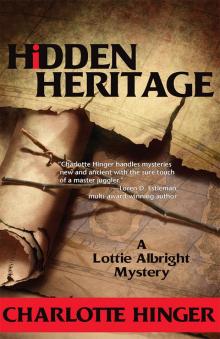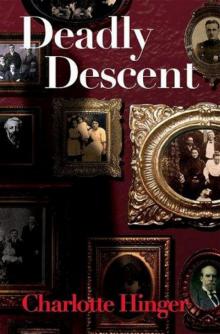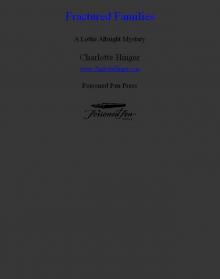- Home
- Charlotte Hinger
Lethal Lineage
Lethal Lineage Read online
Lethal Lineage
Lethal Lineage
A Lottie Albright Mystery
Charlotte Hinger
www.charlottehinger.com
Poisoned Pen Press
Copyright © 2011 by Charlotte Hinger
First Edition 2011
Library of Congress Catalog Card Number: 2010932115
ISBN-13 Print: 9781590588376 Hardcover
ISBN-13 Print: 9781590598390 Trade Paperback
ISBN-13 eBook: 9781615952823
All rights reserved. No part of this publication may be reproduced, stored in, or introduced into a retrieval system, or transmitted in any form, or by any means (electronic, mechanical, photocopying, recording, or otherwise) without the prior written permission of both the copyright owner and the publisher of this book.
Poisoned Pen Press
6962 E. First Ave., Ste. 103
Scottsdale, AZ 85251
www.poisonedpenpress.com
[email protected]
Dedication
This book is dedicated to the three dazzling daughters:
Cheryl Flink, Michele Crockett, and Mary Beth Bieker
Contents
Dedication
Epigraph
Chapter 1
Chapter 2
Chapter 3
Chapter 4
Chapter 5
Chapter 6
Chapter 7
Chapter 8
Chapter 9
Chapter 10
Chapter 11
Chapter 12
Chapter 13
Chapter 14
Chapter 15
Chapter 16
Chapter 17
Chapter 18
Chapter 19
Chapter 20
Chapter 21
Chapter 22
Chapter 23
Chapter 24
Chapter 25
Chapter 26
Chapter 27
Chapter 28
Chapter 29
Chapter 30
Chapter 31
Chapter 32
Chapter 33
Chapter 34
Chapter 35
Chapter 36
Chapter 37
Chapter 38
Chapter 39
Chapter 40
Chapter 41
Chapter 42
Chapter 43
Chapter 44
Chapter 45
Chapter 46
Chapter 47
Chapter 48
Chapter 49
Chapter 50
Chapter 51
Acknowledgments
More from this Author
Contact Us
Epigraph
Terrors are turned upon me; they pursue my soul as the wind, and my welfare passeth away as a cloud.
—Job 30:15 (KJ21)
Chapter One
Happiness happens. Collective joy surges, pulses, and is sweeter when it’s unexpected. Exhilarated, I looked around at the proud faces of the congregation gathered for the first service in our new church, St. Helena. Only dimly remembered snatches of scripture or poetry seemed powerful enough to say what I felt; my heart leapt, my soul soared.
We did it! The Episcopalians in four counties in Western Kansas had miraculously united to build a church. Overwhelmed by gratitude, I dabbed at a tear. We had a church, and were beginning with a special ceremony. My niece, Tammy Clements, would be confirmed here today. A sunbeam spotlighted a patch of our new celadon blue carpet. The scents of new varnish mingled with new wood and over-perfumed women wafted through the air.
A number of relatives were here. After the service the whole congregation was invited to Fiene’s Folly—my husband’s family’s farm—for a grand picnic and a day of music.
Chords sounded from a boom box. Lacking an organ or a piano, it was the best we could do. We rose to the thunderous notes of “A Mighty Fortress is our God.”
The processional began. We lifted our voices unto the Lord. A little acolyte, swollen with self-importance, strutted down the aisle dangerously swinging the brass thurible like it was an aborigine bola meant to bring down little animals. I blinked to ward off the hypnotic attraction of flashing metal.
Beside me my twin sister’s face tightened. For a psychologist, Josie could be surprisingly judgmental, and uncontrolled children always brought on a surge of her disapproval.
A bell tinkled and the attendant calmed down and stilled the censer. More beaming acolytes followed. Sunlight prismed off the raised burnished cross.
The priest, Mary Farnsworth, was next in line. I had not seen her in vestments before. Her multicolored stole bore primitive motifs and appeared to be hand woven. As always, she wore a lovely elongated silver cross that displayed a ruby heart off-center on the body of the stylized Christ. I expected her to be all smiles, but her mouth was tense, her hands trembled. Our paths intersect often in our work as she organizes the social work in Northwest Kansas and I am the undersheriff of Carlton County. I am also in charge of our historical society and edit our county’s history books.
After Mary came the bishop.
I gasped, stunned. My reaction was irrational, but my mind couldn’t stop my heart from speeding up like I’d seen a ghost. The bishop, formally addressed as The Right Reverend Ignatius P. Talesbury, was an Anglican living image of a nineteenth century Catholic bishop I had seen in an old photo. Through my research I had come to look upon that very nineteenth century bishop as Western Kansas’ answer to Darth Vader.
Talesbury looked like an El Greco painting; other-worldly, ascetic, and ghastly pale. He carried the traditional shepherd’s crook and wore the obligatory mitre.
Sensing my tension, Josie stared at me. Not wanting to meet her eyes I turned toward the altar, determined to keep our niece’s confirmation a joyful occasion. We all have a double. Not just we twins. It wasn’t fair to assume Talesbury was a cruel man just because he looked like the photo image of a clergyman from the past.
Tammy sat with her parents in the front row in a sweet pink dress. She’d wanted to be confirmed on her eighteenth birthday and that request had required unconventional arrangements. In the Episcopal Church, only bishops can confirm. Katy Poudre, the lady charged with contacting the Diocese of Western Kansas, had reported that there was a scheduling problem and this confirmation could not take place until much later in the year.
Then Mabel Sidwell, Copeland County’s most excellent professional clubwoman, came to the rescue. She had triumphantly announced that a friend recommended a suffragan bishop who was willing to come on the Sunday Tammy requested. Mabel assured us it would all be perfectly fine and she’d proceeded with the arrangements.
I am a lapsed Episcopalian and don’t know about such things, although Josie and I had attended an Episcopal boarding school and I should have paid more attention. Mabel had explained that these “flying bishops” could just go, well, wherever.
St. Helena was precisely centered on the corners of the four counties initiating the construction. The location had been calculated with a protractor. I’d stayed out of all the debates until Mabel informed me the tentative vestry had approved of an avocado shag carpet for the sanctuary.
Appalled, I’d intervened and offered to donate a blue low plush pile. I’d won the women over by agreeing to perform all necessary Altar Guild tasks. Although I was ignorant of all the responsibilities involved, how hard could it be?
The service progressed. The Bishop had chosen the less familiar Rite One and we responded clumsily, and glanced at our prayer books for phrases usually chanted automatically. More relaxed after the “Glory be to God on High,” I took deep breaths.
Then Bishop Talesbury began his sermon.
Shame. Hot Coals. Harsh scolding. Our fault, our most grievous fault, that the diocese was in dire straits financially. Our fault that our land was barren. Our fault that our economy was sinking like the Ogallala aquifer.
Our own grievous fault.
Beside me, Josie looked around at the congregants’ shocked expressions. Shrewd, evaluating, no longer a participant in this rite, she became a professional assessing collective damage. I followed her gaze.
While Talesbury ranted, Tammy clutched the skirt of her lovely dotted swiss pink dress, compulsively wadding it while she leaned against her mother’s shoulder. Most of the men stared straight ahead, their faces flushed with anger. More than a few of the women dabbed at their eyes with shredded tissues.
Talesbury finally finished. We mouthed the words of the Nicene Creed then stumbled through the ritual required to confirm Tammy and the “laying on of hands” by a bishop. After an eternity, we began the solemn Rite of Holy Communion.
The railing filled once. I tamped down my reluctance to receive the Body of Christ from this man and kept my eyes lowered when I stretched my hands to receive the Host. Then I sipped from the common chalice offered by the Reverend Mary Farnsworth. I looked up at her compassionate brown eyes. They brimmed with tears.
Mary was gentle, kindly, an ideal tentmaker priest, undoubtedly ordained through the provisions of the now defunct canon nine. These priests administered the sacraments to local congregations. But in Mary’s case, “local” meant all of Northwest Kansas. These little worker bees served without any financial support from local parishes.
When I’d expressed my surprise over Mary Farnsworth’s calling, Mabel Sidwell had explained Reverend Mary went exclusively to little house churches. And there were precious few of those.
I rose, turned, and started down the exterior aisle.
A cry. A thud.
I turned back and froze. Mary Farnsworth had dropped the chalice. Unthinkable. Once consecrated, then spilled, the Blood of Christ cannot be retrieved. Dropping the bread, the Body, is bad enough, but it can be salvaged and then buried.
But the blood? The Blood of the Lamb? Never. It’s a dilemma that has haunted both the Roman Catholic and my own Anglican Catholic church for centuries.
“My God,” Josie said.
Mary Farnsworth fled. She ran from the rail into the anteroom where the clergy changed.
Bishop Talesbury’s hands trembled and if it was possible for his face to become even whiter, it just did. He stepped back to the altar and consecrated additional wine. He resumed placing the Body of Christ in the hands of the remaining parishioners, then started over with the chalice as there were no lay clergy present who had the authority to perform this duty.
Mary Farnsworth would no doubt be stripped of subsequent duties because she served at the pleasure of the Bishop. I doubted Talesbury had a forgiving bone in his body. Once a priest, always a priest. Vesting cannot be undone, but there are ways to push errant clergy off on an ice floe.
We would never find another person with her abilities to serve here again. Mother Teresas didn’t grow on trees. I glanced at Tammy. Tears streamed down her face. Her special day ruined by the acidic sermon—and now this.
The grim ceremony concluded. The moment after we squawked through the final notes of the difficult closing hymn, Josie bypassed the crowd starting toward the Bishop’s receiving line outside the church. She headed to the little anteroom and knocked gently on the closed door.
I watched but hung back, knowing my sister would do Mary the most good.
There was no reply. I glanced at Tammy to see if I was needed there, but she was surrounded by a comfort of aunts. So I joined Josie. She knocked again. We waited. She turned, shrugged. People were leaving. Cars trailing dust fled from this little church in the middle of nowhere. Why wouldn’t everyone want to get the hell out as fast as they could? I did too.
“Josie, I have to stay and take care of the linens. Why don’t you go on to the farm and help Keith with the barbeque. Mary’s my friend. Perhaps I can help her the most.”
“All right.” Reluctantly, she turned away from the door. “But please let her know she’s welcome to join us. Maybe she’ll talk to me later.”
“Mary? Are you all right?” There was no reply. I rattled the door knob. “It’s locked,” I whispered to Josie. I kept all the keys to St. Helena on a separate ring. I reached into my purse and found the one to the anteroom, inserted it, and opened the door.
“My God. Oh my God.”
Josie’s hands flew to her face and she took a step backwards.
Mary Farnsworth’s body lay sprawled on the floor.
Chapter Two
“Get out, Josie. Get the hell out. Right now. Just leave. And don’t touch anything.” She swayed. The color drained from her face, even though she’s a clinical psychologist and tough as nails.
As a historian my life should have been an ivory tower existence, but my role at this church had suddenly changed from that of a loving aunt to first responder. Actually, one of the only responders in this county, and now second in charge since I’d been promoted from Deputy Sheriff to Undersheriff of Carlton County. It was supposed to be an honor, but I knew better.
“I’m OK,” Josie mumbled. She stared at Mary, and then me.
“Just go on,” I ordered. “Right now. Are you OK to drive?” She nodded.
“Leave. Don’t say anything to anyone yet.”
This was not a crime scene, but as a professional I was required to follow certain procedures. Sheriff Sam Abbott had made that quite clear. I knelt by Reverend Mary and felt for a pulse to check what I already knew.
Dead.
I called Sam. Silence on the line after my terse message.
“At the church?” he asked. “Just like that?”
“Yes, just like that.”
“Jesus Christ.”
“You’ll call Doc Golbert?” Doc couldn’t bring her back to life but we needed an official cause of death. Golbert is our County Coroner. Our county is too small to have a Deputy Coroner. My guess was Mary died of a heart attack, but only because it was the sole reason I knew for an apparently perfectly healthy woman to keel over.
“Nope,” he said. “He’s out of town and will be gone for a week. Since this is an unattended death we’ll have to send her directly to the District Coroner.”
I sighed. That would mean a hundred mile trip to Hays. We have six counties in our district.
“OK, Sam, I’ll leave it to you to sort this all out.” Normally, the ambulance would take the deceased straight to our undertaker. Gateway City has only one mortician. Like a number of men in small rural towns who have families to support he has two jobs, and is a part time electrician.
I watched Josie give a quick nod to the bishop where he stood outside the church. Having greeted the very last person, Bishop Talesbury came inside. Now only he and I remained.
“I would like a word with you sir.”
“Yes?”
I gazed into his cold eyes. “I have some bad news, sir. Reverend Mary…” My tongue froze. I simply could not get the words out. Suddenly angry at myself for being intimidated by this cold self-righteous son-of-a-bitch, I matched cold with cold. “Reverend Mary is dead.”
He flinched but didn’t speak for thirty seconds. “Three,” he whispered. “How?” He trembled, then clamped down on his body’s betrayal as though he had received ordinary news.
Suddenly conscious that I was in a pale blue linen suit, wearing a corsage of carnations and concerned that he might think I had stayed behind merely as the sole person comprising the Altar Guild, I introduced myself. “I’m Lottie Albright, the Undersheriff of Carlton County. I’ve made all the necessary phone calls. In fact emergency personnel will be arriving shortly.”
“Thank God for that, Miss Albright.” Technically, I was Mrs. Keith Fiene, but I did not c
orrect him. I still use my maiden name professionally as I have published so much under Albright.
We were interrupted by sound of a vehicle arriving; gravel crunching, no siren. Sam’s instructions, no doubt.
“Sir, we do not have an Altar Guild yet. I had planned to stay after the service and take the linens home with me. Our family was going to remove the flowers too. They are from Tammy’s parents and we are having a picnic later.” I sounded anxious, incompetent, and hated myself for it. Hated my haste to counter his cold silence.
The EMT’s came through the door and we watched in even more conspicuous silence as they laid Mary’s body on a stretcher and carried her out to the waiting vehicle.
I collected the few personal items Mary had placed on the table in the anteroom to take to Sam. Her purse lay beside her car keys, a cell phone, and a small plastic bag. I looked inside the bag. It contained miscellaneous health items labeled with the names of the intended recipients.
No doubt she’d planned to visit these people after the service. I dabbed at a few stray tears and vowed to distribute them myself.
I had admired this kindly earnest woman. We’d had a number of conversations due to her job as a social worker. It was my unhappy responsibility to occasionally collect children and place them in foster care. The children of Northwest Kansas had a vigorous advocate in Mary Farnsworth.
The ambulance crew left. Bishop Talesbury turned toward the altar, made the Sign of the Cross, then walked over to the communion elements. He looked back at me reproachfully and I suspected I had ignorantly omitted some duty normally performed by subordinates. Our acolytes had fled with their parents right after the closing hymn.
After dousing the candles, he began consuming the bread and the remaining wine as was required by our church. I waited to gather up the linens to take back to the farm to wash and store. Even under normal circumstances it would have been a while before we used this little church again. We were aiming for once a quarter.
Bishop Talesbury bowed in the direction of the cross. Brass gleamed. The faint aroma of incense still lingered. A residual tang of wine vinegared my tongue. The abnormal silence with which the man moved accentuated body noises. I could hear myself swallow. My breath quickened. If one could hear one’s own blood pulsing, I did now. This little church suddenly so desecrated. Tears threatened, but I would not give in.

 The Healer's Daughter
The Healer's Daughter Hidden Heritage
Hidden Heritage Lethal Lineage
Lethal Lineage Deadly Descent
Deadly Descent Fractured Families
Fractured Families